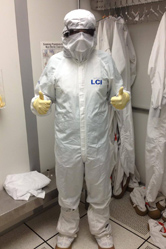Biochemistry and Molecular Biology
“Stimuli-Responsive and Reconfigurable Liquid Crystal Droplets”

Sam Saxena, University of Maryland, Baltimore County
Liang-Chy Chien, Kent State University
Emine Kemiklioglu, Libo Weng
The purpose of this project is to study bio-inspired, stimuli-responsive materials similar to mimosa pudica, a touch sensitive plant. To perform these studies, we used liquid crystal droplets formed in the cholesteric phase, and specifically, liquid crystal droplets that could be induced by an electric field [1,2]. The droplets are formed in homeotropically aligned cholesterics of large pitch. A phase diagram, detailing the droplets and other textures of the cholesteric liquid crystal as a function of applied voltage and cell gap, has been established. The changes in droplet size and density due to various cell gaps and applied voltages were also studied. The conditions of droplet extinction were determined by aging at room temperature, applying an electric field, or applying pressure. Future work will involve a stimuli-response test of azobenzene-doped droplets in response to ultraviolet exposure.
[1] B. Kerllenevich and A. Coche; Bubble domain in cholesteric liquid crystals, Mol. Cryst. Liq. Cryst. 1981, 68, 47-55. [2] R. Hamdi, G. Petriashvili, G. Lombardo, M. P. De Santo and R. Barberi; Liquid crystal bubbles forming a tunable micro-lenses array, J. Appl. Phys., 2011, 110, 1-6.
What research have you been doing this summer?
I am in a Chemistry Research Experience for Undergraduates (REU) sponsored by the National Science Foundation at Kent State University. I work in the Liquid Crystal Institute (LCI) studying liquid crystals, and specifically, the droplet texture they sometimes form.
How did you find out about this opportunity?
I found a webpage through the National Science Foundation that listed several hundred summer research opportunities, many of them at universities around the nation, and many of them REU’s. This program happened to be on that list, and I was interested enough to apply.
Was there a formal application process?
Yes there was. It involved filling out basic information, writing a short essay, and sending my official transcript along with two letters of recommendation
Was this your first independent research project?
Yes, I had never previously done any research, so this was my first research experience.
Do you get course credit for this work or get paid?
I get a stipend for the ten-week program along with housing in an on-campus residence hall. I am working with the Shriver Center to get the PRAC 98 notation on my transcript, along with possibly getting credit for BIOL 398 next semester.
How much time do you put into it?
We are expected to work about eight hours a day, five days a week, but it varies based on each advisor and each project. Some require much more time whereas others do not.
What are the benefits of this research program?
Firstly, I have met a lot of great people in this program: undergraduates, graduate students, professors, and several others along the way. Secondly, all twenty of us in this program get to present a poster detailing our research at a symposium at Case Western Reserve University. They also schedule picnics, academic lectures (with lunch), and other fun events for us.
What has been the hardest part about your work this summer?
The graduate student I was supposed to be directly working with has been out of the country, so it’s difficult when I get stuck on something, or don’t completely understand why something isn’t working the way I expected it to.
What was the most unexpected thing?
I am a biochemistry major, so I expected to be in a lab that involved work with biochemistry or something similar, but instead I am in a chemical physics lab. It was a tough adjustment, but I’m definitely learning a lot!
What is your advice to other students about getting involved in research?
If you have the opportunity to do research, you should definitely do it. A lot of people in my program have a much better sense of what they want to do with their future because of this program, myself included.
What are your career goals?
I am pushing toward medical school. In the future I hope to be able to travel, providing medical care to those who desperately need it in underserved and developing areas.
What else are you involved in on campus?
I am in the pre-medical society, Global Medical Brigades, and the club tennis team. This past year I was a campus tour guide, but next year I will be a Learning Assistant for Dr. Gierasch in CHEM 351!
7/25/2013